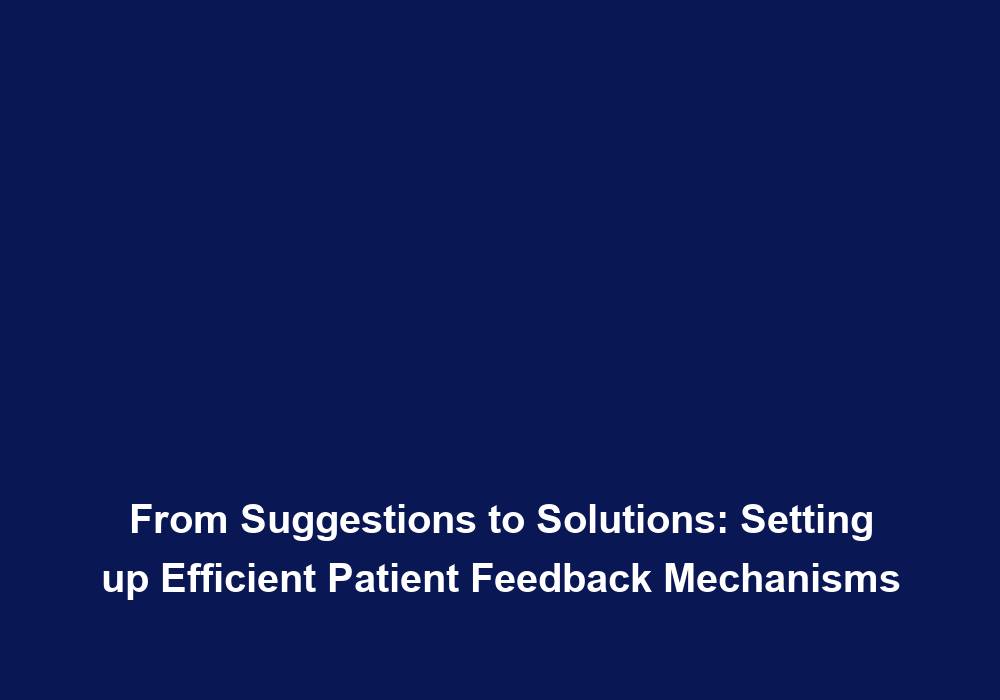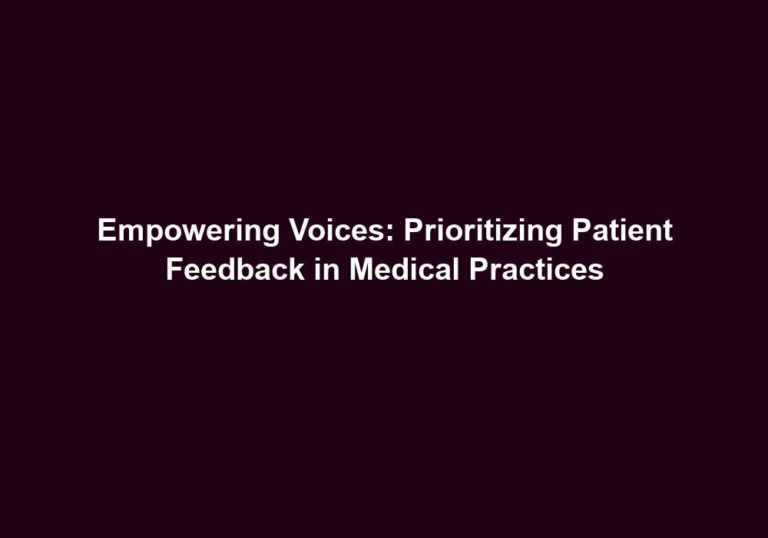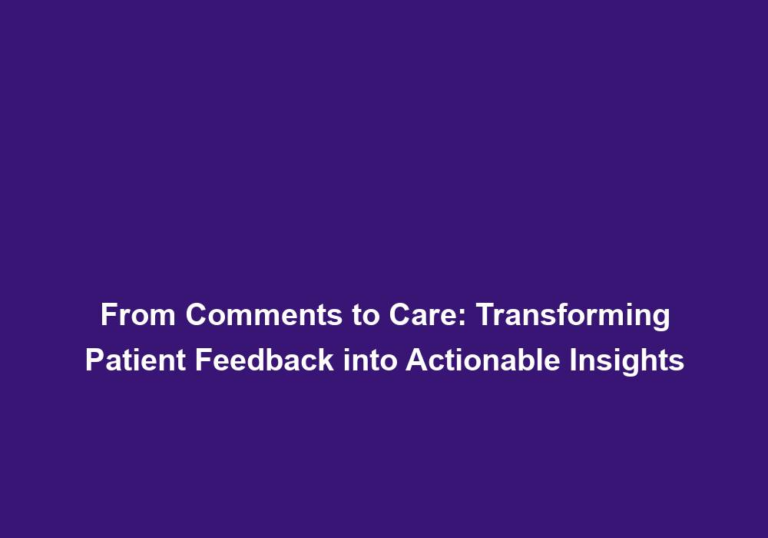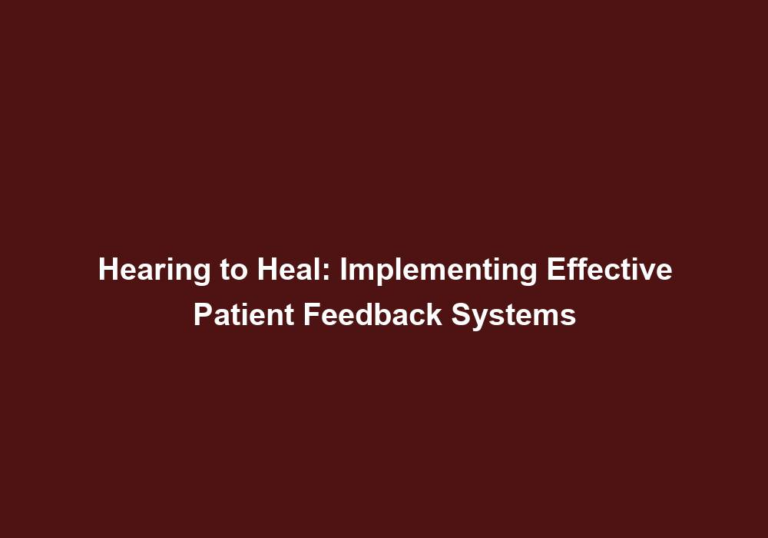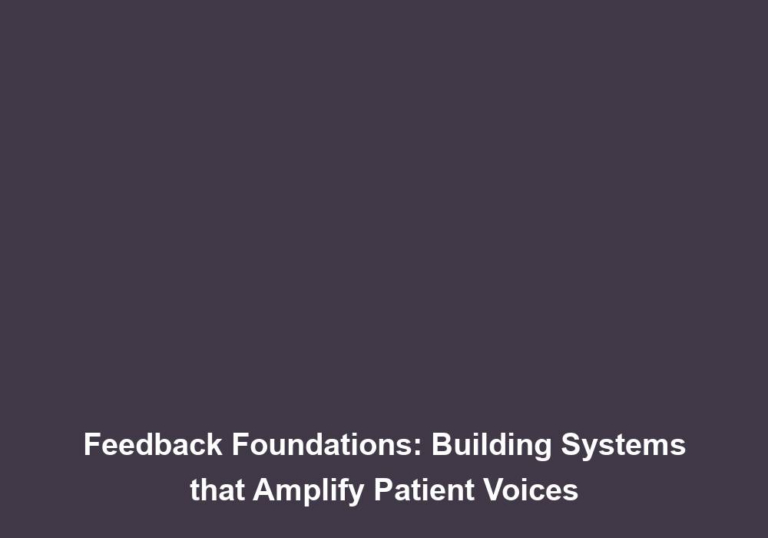Incorporating Insights: Best Practices for Implementing Feedback Mechanisms in Clinics
In today’s dynamic healthcare industry, patient satisfaction and feedback play a crucial role in improving the overall quality of care. Implementing effective feedback mechanisms in clinics can provide valuable insights for healthcare professionals, enabling them to deliver better services and enhance patient experiences. This article will explore the best practices for incorporating feedback mechanisms in clinics and how they can contribute to improved patient care.
Why are Feedback Mechanisms Important?
Feedback mechanisms in clinics serve as a vital tool for capturing patient experience and satisfaction levels. By actively seeking and collecting feedback from patients, clinics can identify areas for improvement and address any concerns or issues promptly. This continuous feedback loop helps in enhancing patient trust, loyalty, and overall satisfaction.
Benefits of Implementing Feedback Mechanisms
- Enhanced Patient Satisfaction: By actively incorporating feedback mechanisms, clinics can ensure that patient concerns are heard and addressed promptly. This leads to improved patient satisfaction, which ultimately contributes to a positive reputation for the clinic.
- By addressing patient concerns promptly, clinics can show their commitment to providing high-quality care, leading to increased patient satisfaction.
- Actively listening to patient feedback and taking appropriate action can help clinics build a strong rapport with their patients, leading to improved satisfaction levels.
- Identifying Service Gaps: Feedback mechanisms enable clinics to identify and address service gaps that may have otherwise gone unnoticed. By analyzing patient feedback, clinics can identify patterns, such as long wait times or communication issues, and take proactive measures to improve these areas.
- Through feedback mechanisms, clinics can identify specific areas where improvements are needed, such as reducing waiting times or improving communication between staff and patients.
- By addressing service gaps, clinics can enhance the overall patient experience, leading to increased satisfaction and loyalty.
- Quality Improvement: Feedback mechanisms provide valuable insights that can be used to enhance various aspects of clinical operations. Whether it’s improving communication, streamlining appointment scheduling, or enhancing the overall patient experience, feedback mechanisms serve as a valuable tool for quality improvement.
- Analyzing patient feedback can help clinics identify areas of improvement in their operations, leading to enhanced quality of care.
- By continuously seeking feedback and implementing necessary changes, clinics can ensure that they are providing the best possible care to their patients.
- Building Patient Trust: Actively seeking patient feedback demonstrates a clinic’s commitment to patient-centered care. This builds trust and fosters a positive relationship between the clinic and its patients, leading to increased patient loyalty and retention.
- When patients see that their feedback is valued and acted upon, they develop a sense of trust in the clinic’s ability to provide quality care.
- Building patient trust through feedback mechanisms can result in increased patient loyalty, as patients are more likely to continue seeking care from a clinic that values their input.
Best Practices for Implementing Feedback Mechanisms
To effectively implement feedback mechanisms in clinics, the following best practices should be considered:
1. Clearly Define Feedback Goals and Objectives
Before implementing any feedback mechanism, it is important to clearly define the goals and objectives. Determine what specific areas of the clinic’s operations and services need improvement, and tailor the feedback mechanism accordingly. This will help in collecting meaningful and actionable feedback from patients.
- Clearly defining feedback goals and objectives ensures that the collected feedback aligns with the clinic’s improvement priorities.
- Tailoring the feedback mechanism to specific areas of improvement helps clinics gather targeted feedback that can drive meaningful changes.
2. Choose the Right Feedback Channels
Select feedback channels that are convenient for patients to use and easily accessible. This can include traditional methods such as suggestion boxes, paper-based surveys, or modern approaches like online surveys, email feedback, or even mobile applications. By offering multiple feedback channels, clinics cater to different patient preferences and increase the likelihood of receiving valuable feedback.
- Offering a variety of feedback channels allows clinics to reach a wider range of patients, ensuring that diverse perspectives are captured.
- Convenient and easily accessible feedback channels encourage patients to provide feedback, leading to a higher response rate and more comprehensive insights.
3. Ensure Anonymity and Confidentiality
Patients may be more willing to provide honest feedback if they feel their responses are anonymous and confidential. Assure patients that their feedback will be kept confidential and that it will only be utilized for the purpose of improving clinic services.
- Ensuring anonymity and confidentiality creates a safe space for patients to express their opinions and concerns without fear of repercussions.
- Communicating to patients that their feedback will be treated with utmost confidentiality encourages open and honest responses.
4. Regularly Monitor and Analyze Feedback
Implementing a feedback mechanism is not enough; clinics must actively monitor and analyze the feedback received. Regularly review patient feedback to identify common themes or concerns, and develop strategies to address them. Consider appointing a dedicated team or individual responsible for analyzing and acting upon the feedback received.
- Regularly monitoring and analyzing feedback allows clinics to identify trends and patterns that can inform decision-making and improvement efforts.
- Having a dedicated team or individual responsible for feedback analysis ensures that feedback is not overlooked and that appropriate actions are taken.
5. Act Promptly and Transparently
Promptly address any concerns or issues raised by patients through the feedback mechanism. Communicate openly and transparently with patients, acknowledging their feedback and outlining the steps being taken to address their concerns. This demonstrates a commitment to continuous improvement and patient-centered care.
- Promptly addressing patient concerns shows that the clinic values their feedback and is committed to resolving any issues.
- Transparent communication regarding the steps being taken to address feedback builds trust and reassures patients that their input is taken seriously.
6. Share Success Stories and Improvements
When improvements are made based on patient feedback, clinics should not hesitate to share these success stories. Communicating the positive changes that have occurred as a result of patient feedback not only acknowledges the impact of patient input but also encourages further participation and engagement from patients.
- Sharing success stories showcases the clinic’s dedication to patient satisfaction and demonstrates the tangible outcomes of patient feedback.
- Highlighting improvements made based on feedback encourages patients to continue providing feedback and actively participate in the improvement process.
7. Foster a Feedback Culture
Creating a culture that encourages and values feedback is essential for the success of feedback mechanisms in clinics. Encourage staff members to actively seek feedback from patients and incorporate it into their daily practice. This culture shift can significantly enhance patient experiences and overall clinic performance.
- Encouraging staff members to seek feedback fosters a patient-centric mindset and promotes continuous improvement.
- Establishing a feedback culture ensures that feedback mechanisms become an integral part of the clinic’s operations and are consistently utilized to drive positive change.
Conclusion
Incorporating effective feedback mechanisms in clinics is a valuable practice that can lead to improved patient satisfaction, service quality, and overall clinic performance. By following the best practices outlined in this article, clinics can create a patient-centric environment that fosters continuous improvement and enhances the overall patient experience. Embracing feedback as a catalyst for positive change ensures that clinics remain at the forefront of delivering high-quality healthcare services.

